Every year, I plant a garden. This year I planted some bush beans, some Thai chili peppers, some little mini bells and three different kinds of tomatoes. I grow them on my deck in containers, even though I have five acres, because in our neighborhood the soil really isn't very good and there are hungry deer everywhere.
Then on Friday, someone left my deck gate open. And a deer came right up on my deck in broad daylight and ate all of my bush beans, about half of my Thai peppers and half of my tomatoes. I'm pretty sure the only reason he didn't eat my bells is because I came home and caught him in the act.
So why am I telling you this? I'm seeking commiseration I guess. Stupid deer.
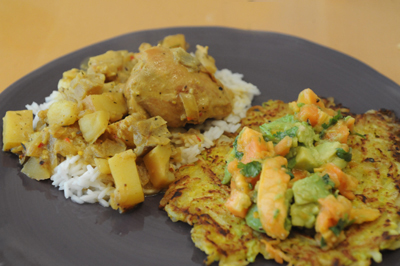 |
 |
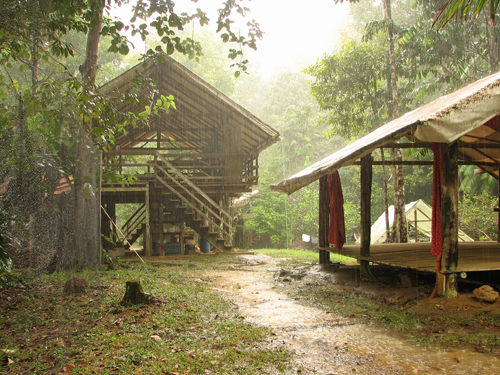 |
| Nouragues French Guiana. Photo credit: Sean McCann (ibycter.com) |
As you might guess, the cuisine in French Guiana is heavily influenced by French cuisine, its coastal waters, and prison food. I'm just kidding about the prison food. French Guianan cuisine is actually quite flavorful, which you wouldn't really expect from prison food. Hot peppers and spices grow in the region and are used to add South American flavor to dishes that are distinctly French in origin.
Of course as you might expect, there really aren't any French Guianan cookbooks, food blogs or other websites. I literally blew a couple of hours just tracking down the three recipes I did find:
Poulet Colombo (Chicken Colombo)
(from Easy French Food)
- 1 chicken cut up, or 8 pieces of chicken
- 1 shallot, peeled and chopped finely
- 6 cloves garlic, peeled and crushed, divided
- 1 tsp ground coriander
- 1 tbsp white wine vinegar
- 1 cup water
- 3 tbsp colombo spices, divided*
- 3 tbsp oil
- 2 onions, peeled and chopped
- 1 chili pepper, minced fine
- 1 medium eggplant, cut into 1/2 inch cubes
- 1 medium zucchini, cut into 1/2 inch cubes
- 3 potatoes, peeled and cut into 1/2 inch cubes
- juice of 1 lemon
- 1 tsp dried thyme
- 1 tsp dried rosemary
- 1 tsp dried basil
- 1 cup coconut milk
- salt and pepper
Chayote-Potato Cakes
(from caribsplendor.com)
- 2 1/2 cups chayote, shredded
- 1 large boiling potato, peeled and shredded (about 2 1/2 cups)
- 1 small yellow onion, shredded
- 2 medium eggs, beaten
- 1/4 cup yellow cornmeal
- 1/2 tsp ground turmeric
- 1/2 tsp freshly ground black pepper
- 1/2 tsp salt
- 1 tsp canola oil
- papaya-avocado salsa*
Colombo Powder
(from About.com Latin Caribbean Food)
- 1/4 cup uncooked white rice
- 1/4 cup cumin seeds
- 1/4 cup coriander seeds
- 1 tbsp black mustard seeds
- 1 tbsp black peppercorns
- 1 tbsp fenugreek seeds
- 1 tsp whole cloves
- 1/4 cup turmeric
So here's how to make the dishes that I did serve:
First the spice powder, which is unusual because of the dried white rice (it helps thicken the food it's added to). It's easy to make and here's how:
Toast the rice in a dry pan until it starts to turn a light golden color. Keep stirring so it doesn't burn.
Transfer the rice to a bowl and let cool. Meanwhile, put your spices (except the turmeric) into the same dry pan and toast them until fragrant, stirring constantly. Let cool.
Put the toasted rice and toasted spices into a grinder or a mortar and pestle and process to a fine powder. Add the turmeric. Done!
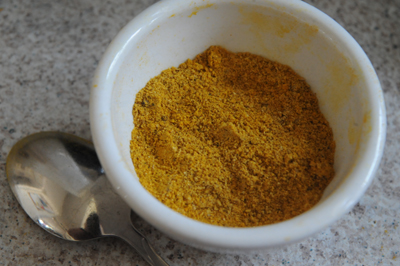 |
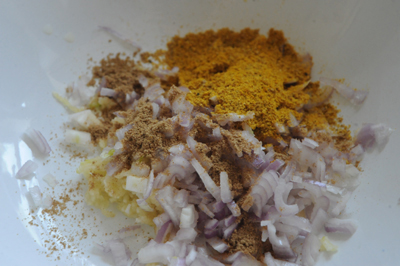 |
Now heat the oil over a medium flame and add the onions, chili pepper and the rest of the garlic. Cook until the onion is translucent. Add the chicken (reserving the marinade) and brown on both sides, then add the vegetables, lemon juice, herbs and the marinade. Cover and cook over a medium-low flame for 15 minutes.
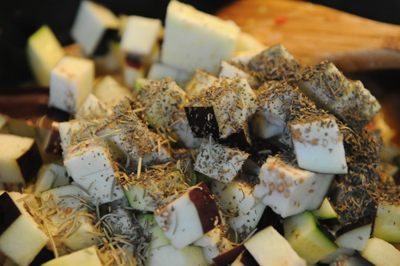 |
 |
Place the chayote, potato and onion in a potato ricer and squeeze out all of the excess moisture. Place in a bowl and add the eggs, cornmeal and seasonings.
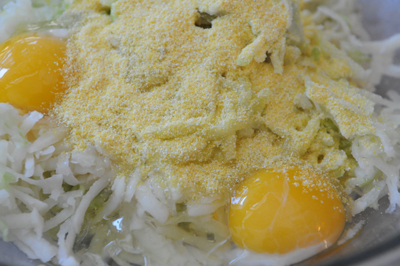 |
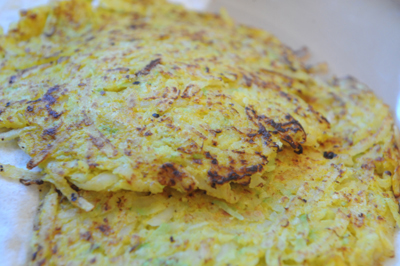 |
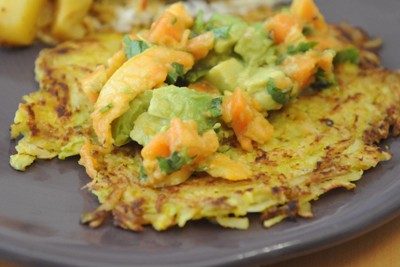 |
The chicken was a different twist on a curry—there were a lot of curry flavors in it but most curries don't have the quantity of vegetables that this one had. This really could have easily been a one-dish meal, since there was plenty of protein, vegetable and starches just on that one side of the plate. I'm not crazy about eggplant really but I thought this was a good use for it, though I might accidentally forget to put it in if I ever made this recipe again.
So that's the first in our five week foray into countries that begin with the word "French." Next week: French Polynesia.
For printable versions of this week's recipes:











Hi! I just stumbled across your blog today while looking for recipes from Chad, of all places, and I was delighted to discover that there are others out there traveling around the world from the confines of their own kitchens.
ReplyDeleteWe're doing a similar expedition in our household, though we've just started on our journey, and we're far less organized, being dependent upon my four-year-old's finger on a globe to choose the next destination. We're also vegetarian, which is going to be interesting when we get to reindeer. I'm just sayin'.
Your blog is inspiring! I'm looking forward to including it in my regular Thursday reading from now on! (And when you get to the Philippines, you can read my blog for some veggie ideas if you like... we started there!)
Peace,
Megan
Hi Megan, thanks for reading! I love your method for choosing countries, I wish I'd thought of that, haha. I admire your plan to tackle this challenge vegetarian-style--it's really difficult to find non-meat dishes for some of these nations, especially the northern ones where nothing green grows and meat/fish are the staple foods. On the flip side of course there are many nations (especially in Africa) where meat is a luxury and there are lots of really delicious vegetarian dishes that are eaten daily, with meat reserved for special occasions.
ReplyDeleteThis has been a really fun adventure for us and I hope you enjoy it too and will keep reading! I usually try to include a vegetable or legume/rice/potato dish with every meal, (though occasionally I'm unsuccessful) so hopefully you can find some inspiration here. :)
You could have used that deer last week. Oh, wait, that was reindeer.
ReplyDeleteHa! I'm sure I could come up with some traditional recipes for venison. :)
ReplyDelete